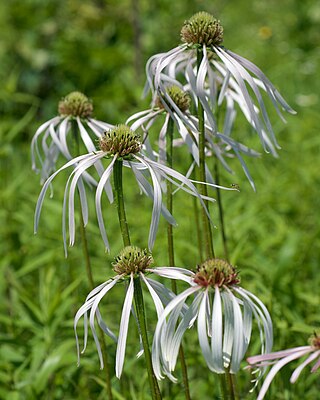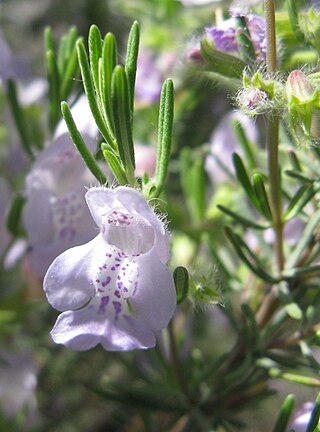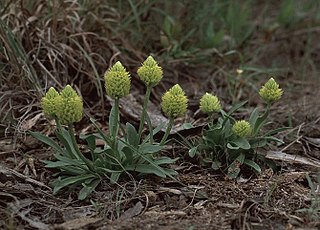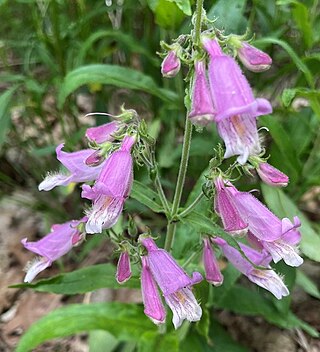
Trillium is a genus of about fifty flowering plant species in the family Melanthiaceae. Trillium species are native to temperate regions of North America and Asia, with the greatest diversity of species found in the southern Appalachian Mountains in the southeastern United States.

Trillium erectum, the red trillium, also known as wake robin, purple trillium, bethroot, or stinking benjamin, is a species of flowering plant in the family Melanthiaceae. The plant takes its common name "wake robin" by analogy with the European robin, which has a red breast heralding spring. Likewise Trillium erectum is a spring ephemeral plant whose life-cycle is synchronized with that of the forests in which it lives. It is native to the eastern United States and eastern Canada from northern Georgia to Quebec and New Brunswick.

Sedum is a large genus of flowering plants in the family Crassulaceae, members of which are commonly known as stonecrops. The genus has been described as containing up to 600 species, subsequently reduced to 400–500. They are leaf succulents found primarily in the Northern Hemisphere, but extending into the southern hemisphere in Africa and South America. The plants vary from annual and creeping herbs to shrubs. The plants have water-storing leaves. The flowers usually have five petals, seldom four or six. There are typically twice as many stamens as petals. Various species formerly classified as Sedum are now in the segregate genera Hylotelephium and Rhodiola.

Helianthus is a genus comprising about 70 species of annual and perennial flowering plants in the daisy family Asteraceae commonly known as sunflowers. Except for three South American species, the species of Helianthus are native to North America and Central America. The best-known species is the common sunflower. This and other species, notably Jerusalem artichoke, are cultivated in temperate regions and some tropical regions, as food crops for humans, cattle, and poultry, and as ornamental plants. The species H. annuus typically grows during the summer and into early fall, with the peak growth season being mid-summer.

Arabia Mountain, a part of Arabia Mountain National Heritage Area, is the northern of two peaks in the Davidson-Arabia Mountain Nature Preserve, in DeKalb County, Georgia, United States. A low saddle separates it from Bradley Mountain, several hundred feet to its south. The two form a monadnock. The peak is 955 feet (290 m) above sea level, rising 172 feet (52 m) above Arabia Lake reservoir. Bradley Mountain is closer to the visitor trails than Arabia Mountain and is often misidentified by visitors as Arabia Mountain.

Prunus maritima, the beach plum, is a species of plum native to the East Coast of the United States. It is a choice wild edible and its few pests and salt tolerance make it a resilient fruit crop for degraded lands and urban soils.

Trillium rugelii, also known as the southern nodding trillium or illscented wakerobin, is a species of flowering plant in the family Melanthiaceae. It is native to parts of the southeastern United States. It is found in the Great Smoky Mountains, Fernbank Forest, Steven's Creek Heritage Preserve, and other places of the Piedmont and southern Appalachian Mountains in Alabama, Georgia, South Carolina, North Carolina and Tennessee. It prefers to grow near streams in humus-rich soil under the shade of deciduous trees.

Hylotelephium telephium, known as orpine, livelong, frog's-stomach, harping Johnny, life-everlasting, live-forever, midsummer-men, Orphan John and witch's moneybags, is a succulent perennial groundcover of the family Crassulaceae native to Eurasia. The flowers are held in dense heads and can be reddish or yellowish-white. A number of cultivars, often with purplish leaves, are grown in gardens as well as hybrids between this species and the related Hylotelephium spectabile (iceplant), especially the popular 'Herbstfreude'. Occasionally garden plants may escape and naturalise as has happened in parts of North America.

Echinacea pallida, the pale purple coneflower, is a species of herbaceous perennial plant in the family Asteraceae. It is sometimes grown in gardens and used for medicinal purposes. Its native range is the central region of the United States and Ontario, Canada.

Conradina is a genus of flowering plants in the mint family, Lamiaceae. Its common name is false rosemary, or rarely, short leaf rosemary. There are 7 species of Conradina, all native to the southeastern United States. Conradina verticillata grows on the Cumberland Plateau in Kentucky and Tennessee. The other five grow mainly in Florida. All of the species are closely related and there is some doubt about whether they are all separate. Most species occupy xeric habitats with well-drained soils composed of white sand. The genus Conradina was established by Asa Gray in 1870. It was named for the American botanist Solomon White Conrad.

Pycnanthemum is a genus of herbaceous plants in the mint family (Lamiaceae). Species in this genus are often referred to as "mountain mints" and they often have a minty or thyme-like aroma when crushed. All species of Pycnanthemum are native to the United States and Canada. The center of diversity for the genus is North Carolina with 13 of the 20 species having been collected therein. Nineteen of the 20 species of Pycnanthemum occur in the Eastern US and Canada, and one disjunct species occurs in California and Oregon.

Sedum spathulifolium is a species of flowering plant in the family Crassulaceae known by the common names broadleaf stonecrop, yellow stonecrop, and spoon-leaved stonecrop. An evergreen perennial, it is native to western North America from British Columbia to southern California, where it can be found often in shade in many types of rocky habitat in coastal and inland hills and mountains.

Silene ovata, the Blue Ridge catchfly or ovate-leaved catchfly, is a herbaceous plant in the family Caryophyllaceae. It is a perennial plant growing up to 1.5 m tall, that has numerous white flowers, each finely fringed with a tube. It has large opposite leaves without petioles, which are 5–12 cm (2.0–4.7 in) long and taper to a long point, and 2–5 cm (0.79–1.97 in) wide.

Chelone obliqua, the red turtlehead, rose turtlehead or pink turtlehead, is a perennial flowering plant belonging to the family Plantaginaceae. This uncommon wildflower is endemic to the United States, where it is found in the Midwestern and southeastern states.

Iris prismatica, the slender blue flag or cubeseed iris, is a plant species native to parts of the southern and eastern United States from Maine south to Alabama, as well as to the Canadian provinces of Ontario and Nova Scotia.

Polygala nana, commonly known as candyroot or low bachelors' buttons, is a small herbaceous plant native to the southeastern United States. The root has a sweet liquorice flavor when it is chewed, but it is usually hidden underground until the plant flowers. The seeds of candyroot are dispersed by ants.
Arisaema stewardsonii is a species of flowering plant in the arum family Araceae. It is a member of the Arisaema triphyllum complex, a group of closely related taxa in eastern North America. The specific name stewardsonii honors American botanist Stewardson Brown (1867–1921). It is commonly known as the bog Jack-in-the-pulpit. It is sometimes referred to as the swamp Jack-in-the-pulpit, not to be confused with Arisaema pusillum, which is also known by that name.

Helianthus eggertii, known as Eggert's sunflower, is a North American species of flowering plants in the family Asteraceae. It is native to Tennessee, Kentucky, South Carolina, and Alabama. It is best known as one of the few plants to have been delisted under the Endangered Species Act because of the species' recovery. It was described by John Kunkel Small in 1903.

Solidago roanensis, the Roan Mountain goldenrod, is a North American species of goldenrod in the family Asteraceae. It is native to the eastern United States, primarily the Appalachian Mountains from Pennsylvania to Georgia, with some populations in the lowlands of South Carolina.

Penstemon smallii is a species of flowering plant also known as Small's penstemon. They are native to the mountains of the Southeastern United States. They are state listed in Georgia (S1), Alabama (S1), Tennessee (S3), North Carolina (S3), and South Carolina (S2).





















